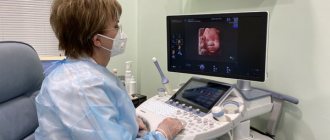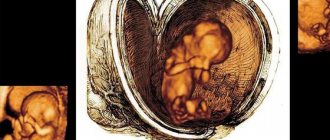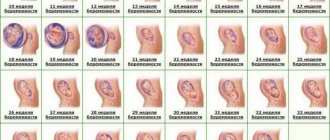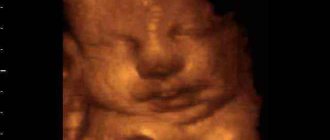The baby already weighs almost a whole kilogram - about 850-900 g, and his height is now approximately 32.5 cm. He already hears perfectly. Listen to classical music together more often; children especially like Mozart and Vivaldi; also play your favorite works. You will soon learn to understand what he likes and what he doesn’t like. Your baby's lungs continue to develop and he continues to take breaths and swallow amniotic fluid. At 26 weeks, boys' testicles begin to descend and take their place in the scrotum.
The skin of the fetus is still very tender, thin and reddish. There are still a lot of wrinkles, but they continue to smooth out. The arms and legs are gradually rounded. The cartilages of the nose and ears of the fetus are still very soft, the nails are hidden under the skin. This and the next few weeks are characterized by particularly active, erratic movements of the baby. There is still enough space for it; it moves freely in the amniotic fluid, the volume of which is now about 700 ml. He has not yet taken a stable position; most often the baby’s legs are at the bottom. His heart beats at a speed of 120-160 beats per minute, you have probably listened to his beat many times already.
What's happening
26 weeks of pregnancy is the point at which the fetal pituitary gland releases growth hormone. Your baby's brain establishes a connection with the adrenal cortex, due to which other hormones begin to be produced. At this time, the formation of the pulmonary alveoli is completed, the lungs themselves take their final place.
The rudiments of baby and molar teeth are already formed, and the latter become ossified at the 26th week of pregnancy. The child’s skin gradually smoothes out and changes its color, and the skeletal system continues to strengthen. Your baby is already able to see, but he is still very far-sighted, and everything appears to him in the form of blurry colored spots.
The baby is very active, and you constantly feel his movements. At 25–26 weeks of pregnancy, the fetus is most often positioned upside down, but can easily change position. This should not be a cause for alarm now.
The child hears well, he is able to distinguish voices and even remember music. Start singing lullabies to him, and after birth the baby will calm down to the sounds of a familiar melody.
Purposes of ultrasound diagnostics
According to the rules, 3 scheduled ultrasounds are performed during the entire period of pregnancy. If a pregnant woman is at risk of developing certain pathologies, the doctor prescribes additional diagnostics. Also, the reason for performing an additional ultrasound examination is to clarify the date of the expected birth. Considering the peculiarity that from the very beginning of the third trimester, each child develops individually, the sonologist needs to very carefully examine the development of all organs of the fetus.
During ultrasound diagnostics, the specialist specifies the volume of amniotic fluid. Their quantity should be 700 grams. The quality of amniotic fluid is assessed; it should be less thick at this stage. This is due to the dilution of water with the child’s urine. The quality of amniotic fluid is affected by the nutrition of the expectant mother. Having determined the quality of the water, the doctor can make adjustments to the pregnant woman’s diet.
During an ultrasound, the sonologist pays special attention to the child’s lungs. By this time, they have practically completed their formation; they have distinct triangular contours, the apex of which is directed upward.
At week 26, the process of lowering the testicles into the scrotum continues. It must be completed by the time of birth. At this time, the child’s hormonal system works. The work of the pituitary gland (growth hormone) is observed. The heart is characterized by active work during this period. It performs 160 beats/minute.
By week 26, permanent teeth are formed in the gums. The baby is able to remember music. After childbirth, a certain reaction is observed when listening to music familiar to the child.
Researchers have proven that at this stage of development the baby is able to distinguish and respond to the tone of the mother's voice. He experiences the same emotions as his mother.
How you feel
The growing belly by 25 - 26 weeks of pregnancy cannot but affect your well-being, and you still experience all the accompanying symptoms. Shortness of breath, heartburn, bloating, calf cramps, constipation and other troubles, unfortunately, become constant companions of expectant mothers until the birth of the baby. Towards the end of the second trimester, the level of hemoglobin in the blood often drops, so the gynecologist may prescribe iron supplements.
At 26 weeks of pregnancy, most women are already well aware of what back and lower back pain is. To minimize discomfort, rest more on the sofa: lying down with your legs stretched out will relieve your spine. A good way to prevent back pain is yoga or gymnastics for pregnant women.
By the 26th week of pregnancy, many expectant mothers may begin to feel pain in the ribs or hypochondrium. It is associated with pressure from the uterus on internal organs or sudden movements of the child. Try to find the optimal body position in which the pain will not be so pronounced.
If you have signs of hemorrhoids, do not ignore these symptoms under any circumstances. Tell your doctor about the problem and discuss with him the possibility of using rectal suppositories or other medications approved at 26 weeks of pregnancy. Be prepared for headaches. To avoid them, you need to walk more in the fresh air and get proper rest. If you still have a headache, lie down in a dim, well-ventilated room and try to fall asleep - often sleep helps to cope with this kind of ailment.
Risk factors
The dangers of the 25th – 26th week are the risk of developing preeclampsia, iron deficiency anemia and premature birth. Even a common cold can provoke an abortion. Therefore, the expectant mother should protect herself from hypothermia, avoid negative emotional experiences and solve health problems in a timely manner. If you have a stomach ache or unusual vaginal discharge, consult your gynecologist without delay.
Also at this stage, ultrasound results can reveal a pathology such as premature aging of the placenta. It occurs when:
- Multiple pregnancy;
- Endocrine diseases (diabetes mellitus, hypothyroidism, thyrotoxicosis);
- Violation of the structure of the uterine wall associated with previous difficult births or abortions;
- Chronic diseases of the respiratory, cardiovascular and urinary systems;
- Complications of pregnancy (late toxicosis, Rh conflict, incorrect location of the placenta, intrauterine infection);
- Intoxication (smoking, drinking alcohol).
At 25–26 weeks of pregnancy, the mechanism for delivering nutrients and oxygen from mother to baby may be disrupted, which is why fetal development is delayed and there is a risk of oxygen starvation. At the first signs of aging of the placenta, it is necessary to urgently begin treatment. Then the risk of an unfavorable outcome will be minimized.
Possible complications
Modern medicine makes it possible to maintain pregnancy in case of most complications. It is only important to seek help in time and regularly see your doctor. Be attentive to your condition and do not wait for your health to worsen.
Isthmic-cervical insufficiency
Normally, the cervix dilates only during childbirth. But in some women, due to tissue weakness, the cervix opens long before childbirth. The condition is usually asymptomatic and discovered during a routine examination. Occasionally, a pregnant woman may complain of minor spotting.
Premature dilatation is treated surgically - sutures are placed on the neck or a pessary is installed. This is a special ring-shaped device that prevents the internal opening from opening. The woman is recommended to wear a bandage, and maintenance hormonal therapy is prescribed according to indications.
Medical observation
Most likely, the second planned ultrasound examination is already behind you, but it happens that the doctor orders an ultrasound scan at the 26th week of pregnancy. The examination may be necessary for medical reasons or if for some reason it was not done earlier.
During an ultrasound, a specialist will look at how the internal organs of the fetus and its skeleton are developing, and will also determine the risk of defects of the nervous system and other abnormalities. In addition, the uterus is examined: the condition of the internal muscle layer, the attachment site and location of the placenta, the quality and quantity of amniotic fluid.
Also, at 26 weeks of pregnancy, a general urine and blood test is prescribed, sugar levels and hemoglobin are checked, after which, if necessary, a special diet or medications are recommended to adjust the indicators. Women who are Rh negative are given an antibody test.
Condition of the uterus
The sonologist pays special attention to examining the condition of the uterus during an ultrasound examination. By the 7th month of pregnancy, this organ reaches impressive sizes:
- Width – 16 cm;
- Height 24 cm.
By this period, it is located 26 centimeters above the pubis (this is approximately 6 cm above the navel). In each subsequent week, the height of this organ will change by 1 cm. Increasing in size, it puts pressure on the organs of the expectant mother located inside the peritoneum. Because of this effect, a pregnant woman can experience bloating, heartburn, and constipation.
The cervical canal is filled with a mucus plug. At the time of birth, she must come out. At week 26, periodic contractions may appear. They are painless and irregular. This is a kind of preparation of the uterus for childbirth. You should call a doctor if you have pain or discharge during contractions.
At week 26, the amount of discharge may increase due to the formation of a mucus plug. With homogeneous light, whitish discharge, there is no need to worry. They are considered the norm. If the discharge is greenish and cheesy, it means that there is an infection in the body that needs to be cured.
Recommendations at 26 weeks of pregnancy
At 25-26 weeks of pregnancy, it’s time to start preparing for feeding: wash your breasts with cool water, take air baths, gently massage your nipples with a hard towel, but do not irritate them too much so that the uterus does not become toned.
A growing belly is making it difficult for you to sleep. For greater comfort, take small pillows with you to bed that you can place under your back, stomach, legs, or buy a special crescent-shaped pillow.
26 weeks of pregnancy is a period when rest is very important, but do not forget that movement is necessary for health. If there are no contraindications, walk, do gymnastics, but do not lift heavy objects. Now you need to be careful and beware of falling, because it can provoke placental abruption, premature rupture of amniotic fluid and the onset of labor. Don't overwork yourself, and if you feel weak, lie down immediately. Squatting pose helps with shortness of breath.
At 25–26 weeks of pregnancy, continue to monitor your weight. Try to control your appetite and eat only fresh, healthy foods for your baby.
Cervicometry as a way to measure the cervix.
Cervicometry under ultrasound is carried out in two ways. Regardless of the choice of cervicometry method, both are effective, so the method of implementation depends on the characteristics of the body and the indications for the use of each of them:
- The transabdominal route is a method of performing cervicometry through the abdominal cavity. This type of study requires a full bladder. With this research method, the visibility of the internal pharynx is poor, and without its results, the data obtained may not be entirely correct.
- Transvaginal is a method of performing cervicometry by inserting a sensor directly into the vagina; during this study, the bladder must be emptied. When performing cervicometry using the transvaginal method, there is no danger to the fetus or the mother, and the norm for carrying out this procedure is considered to be no more than three times during the entire period of gestation.
Ultrasound is usually performed from 18 to 22 weeks of pregnancy. Often, cervicometry is carried out together with other studies. If termination of pregnancy has already occurred, then the study is carried out at an earlier date, starting from 10 weeks, this is done to prevent possible termination of pregnancy. Cervicometry is a fairly convenient and effective type of examination that allows you to maintain pregnancy and identify possible pathological disorders in the early stages of pregnancy.
To prepare for cervicometry using the transvaginal method, it is necessary to empty the bladder. The specialist conducting the research will do the rest, and after the examination he will give the necessary recommendations.
It is worth noting that the cervical examination procedure itself using an ultrasound sensor is absolutely harmless to the unborn child. The woman also does not feel any action during cervicometry. There is no reason to worry about undergoing cervicometry, since the appointment of the procedure does not pose any harm and there is no reason to worry about side effects after the procedure - there are simply none. Carrying out cervicometry completely eliminates the risk of complications and reduces the likelihood of pregnancy failure to zero.







